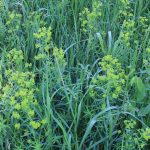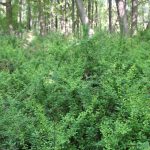City considers demonstration site in Waupaca
By Angie Landsverk
City of Waupaca officials are considering how to address a property owner’s request to use goats and horses on their property to reduce the invasive plants on it.
“It sounds like there are different pathways there,” Andrew Dane said on June 5, during the city’s Plan Commission meeting.
He is the city’s interim development director and is tasked with doing more research on the topic before the commission meets again on July 10.
Kari Esbensen and Russ Butkiewicz own the 34-acre site off of Constance Road.
It includes the former 22-acre Oz Natural Area parcel.
The property is zoned heavy industrial and forms the city’s northeastern boundary with the town of Waupaca.
Last November, they presented their idea to the Plan Commission of using up to nine goats and two horses on it for rotational grazing.
Members of the commission wanted city staff to look into it.
Brennan Kane, the city’s former director of community and economic development, told them the commission he would get something back to it within 45 to 60 days.
In early May, Esbensen attended the common council meeting and said that time period “came and went.”
Mayor Brian Smith said the appropriate place for the discussion is the Plan Commission.
Plan Commission to consider options
Ald. Alan Kjelland, a member of the commission, requested it be on this month’s agenda.
There are some parcels in the city that are not zoned agriculture, do not abut to residential and have invasive plants on them, he said.
Kjelland wants to see the commission propose an ordinance variance or special use permit to allow some type of grazing on some properties.
“I’d like to see it set up on a pilot basis,” he said.
The mayor favors doing so on a trial basis to see how it works on the property owned by Esbensen and Butkiewicz.
He believes their site is a good place to start to see how it works.
They propose a Center for Biodiversity Education on the site.
Butkiewicz told the commission they want to be a demonstration site for how to manage invasive plants without using pesticides.
They believe as a private educational institution and zoological garden, they would already be able to do so under an existing city ordinance.
That is one thing Dane is researching.
They hope to begin using animals this summer for rotational grazing with a 10,000-square-foot demonstration plot.
A 5-foot tall permanent fence would surround it.
Esbensen said their property is unique.
It includes a prairie, woodlands and a wetland.
Invasive plants
The invasive plants on their site include Japanese Barberry, Leafy Spurge, Buckthorn and Autumn Olive.
When they first bought the property more than 20 years ago, there were few Barberry plants on it, she said.
“A lot of animals are being restricted by the Barberry,” Butkiewicz said.
They do not want to harm animals by spraying chemicals, he said.
Last fall, they did a round of chemical treatment in some areas.
The family also manually pulls some invasive plants.
They propose using both goats and horses on their property because each animal favors different plants, Esbensen said.
“They work in tandem,” she said.
Rachel Bouressa told the commission management is key.
She is a grazing planner with the Golden Sands RC&D Council Inc.
The typical grazing season in Wisconsin is May 16 to Nov. 15, Bouressa said.
More desirable plants come back if they are given the opportunity, she said.
Animals graze in different ways.
“Basically, you’re taking animals and letting them do what they’re designed to do,” she said.
Esbensen said they want their parcel to continue being a demonstration site for others.
“We’re trying to create happy co-existence,” she said. “That’s our motto.”


